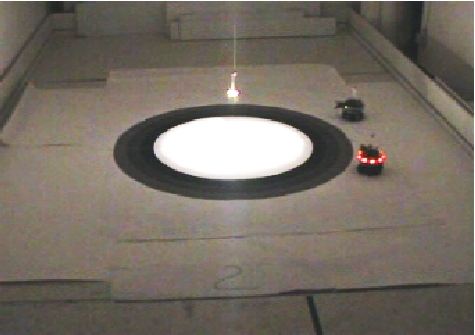
by Christos Ampatzis, Elio Tuci, Vito Trianni, and Marco Dorigo
July 2006
|
To appear in proceedings of the Workshop in Swarm Robotics - SAB 2006
Table of Contents |

Below are sample movies from the experiments performed in the arena above:
Experiments with 2 robots.
Movies are encoded in wmv format.
Experiments with 4 robots.
Movies are encoded in mpeg format.
All videos recordings from all the trials can be accessed at:
http://www.swarm-bots.org/integration-over-time.html
Experiments in simulation are performed with two robots and in reality with two and four robots. Movies are taken from an overhead camera and a hand camera and are encoded in .mpg or .wmv formats. Notice that when the robots emit a sound signal we light their colour turret red for visualisation purposes.
The behaviour of the group for the two robots is analysed
in the paper. Concerning the four robots experiment, the results are
almost perfect. In one trial though, Robot E while performing
antiphototaxis as a reaction to the sound emitted by Robot C, made a
turn of 180 degrees and started moving wrongly towards the light. In
all other trials though we did not observe this error and it looks to
be a hardware crash. Another error which was not expected and revealed
some property of our controller about which we would not have found
out had we not performed the four robot test, is the fact that the
robot-robot avoidance behaviour does not work while the robots perform
antiphototaxis. In fact, as they leave the band after they perceive a
sound signal, their sensorial input is ignored, with the consequence
that in case they encounter another agent on their way, they collide
against each other. A possible explanation for this is that this
condition was never encountered during evolution, and therefore the
mechanism shaped was confined to just leaving the band without paying
attention to obstacles (other robots). Finally, by allowing more
agents to interact in the target area, we discovered that the
robot-robot avoidance mechanism is different once the robots are
interacting there---a case not often encountered during the two robot
experiments--and can be described as follows: if an agent detects
others in its vicinity, it stops and spins until the other agents have
moved away.